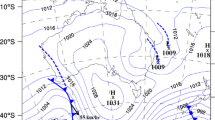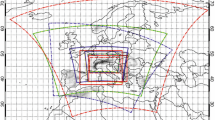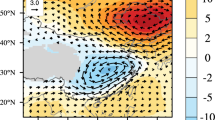Abstract
Conclusions on the General Circulation Models (GCMs) horizontal and temporal optimum resolution for dynamical downscaling of rainfall in Mediterranean Spain are derived based on the statistical analysis of mesoscale simulations of past events. These events correspond to the 165 heavy rainfall days during 1984–1993, which are simulated with the HIRLAM mesoscale model. The model is nested within the European Centre for Medium-Range Weather Forecasts atmospheric grid analyses. We represent the spectrum of GCMs resolutions currently applied in climate change research by using varying horizontal and temporal resolutions of these analyses. Three sets of simulations are designed using input data with 1°, 2° and 3° horizontal resolutions (available at 6 h intervals), and three additional sets are designed using 1° horizontal resolution with less frequent boundary conditions updated every 12, 24 and 48 h. The quality of the daily rainfall forecasts is verified against rain-gauge observations using correlation and root mean square error analysis as well as Relative Operating Characteristic curves. Spatial distribution of average precipitation fields are also computed and verified against observations. For the whole Mediterranean Spain, model skill is not appreciably improved when using enhanced spatial input data, suggesting that there is no clear benefit in using high resolution data from General Circulation Model for the regional downscaling of precipitation under the conditions tested. However, significant differences are found in verification scores when boundary conditions are interpolated less frequently than 12 h apart. The analysis is particularized for six major rain bearing flow regimes that affect the region, and differences in model performance are found among the flow types, with slightly better forecasts for Atlantic and cold front passage flows. A remarkable spatial variability in forecast quality is found in the domain, with an overall tendency for higher Relative Operating Characteristic scores in the west and north of the region and over highlands, where the two previous flow regimes are quite influential. The findings of this study could be of help for dynamical downscaling design applied to future precipitation scenarios in the region, as well as to better establish confidence intervals on its results.









Similar content being viewed by others
References
Alpert P, Krichak SO, Krishnamurty TN, Stein U, Tsidulko M (1996) The relatively roles of lateral boundaries, initial conditions and topography in mesoscale simulations of Lee cyclogenesis. J Appl Meteorol 35:1091–1099
Amengual A, Romero R, Gómez M, Martín A, Alonso S (2007) A hydro-meteorological modeling study of a flash-flood event over Catalonia, Spain. J Hydrometer (in press)
Antic S, Laprise R, Denis B, de Elía R (2004) Testing the downscaling ability of a one-way nested regional climate model in regions of complex topography. Clim Dyn 23: 473-493
Beck A, Ahrens B, Stadlbacher K (2004) Impact of nesting strategies in dynamical downscaling of reanalysis data. Geophys Res Lett 31:L19101
Buzzi A, Tibaldi S (1978) Cyclogenesis in the lee of the Alps: a case study. Q J R Meteorol Soc 104:271–87
Denis B, Laprise R, Caya D, Côté J (2002) Downscaling ability of one-way nested regional climate models: the Big-Brother Experiment. Clim Dyn 18:627–646
Denis B, Laprise R, Caya D (2003) Sensitivity of a regional climate model to the resolution of the lateral boundary conditions. Clim Dyn 20:107–126
Diaconis P, Efron B (1983) Computer-intensive methods in statistics. Sci Am 248:116–130
Dimitrijevic M, Laprise R (2005) Validation of the nesting technique in a regional climate model and sensitivity tests to the resolution of the lateral boundary conditions during summer. Clim Dyn 25:555–580
Doswell CA, Ramis C, Romero R, Alonso S (1998) A diagnostic study of three heavy precipitation episodes in the western Mediterranean region. Weather Forecast 13:102–124
Giorgi F (1990) Simulation of regional climate using a limited area model nested in a general circulation model. J Clim 3:941–963
Giorgi F, Mearns LO (1999) Introduction to special section: regional climate modeling revisited. J Geophys Res 104(D6):6335–6352
Homar V (2001) Synoptic and Mesoscale study of western Mediterranean severe weather events through numerical simulation: application of factors separation and PV inversion techniques. Ph D. thesis, available from the Universitat de les Illes Balears
IPCC (2001) Third assessment report: climate change 2001 (Synthesis Report). In: Watson RT, Core Writting Team (eds), IPCC, Geneva, Switzerland, pp 184
Jansà A, García-Moya JA, Rodríguez E (1991) Numerical experiments on heavy rain and mediterranean cyclones. WMO/TD 420:37–47
Källén E (1996) HIRLAM documentation manual, available from SMHI S-60176 Norrkoping. Sweden
Louis JF (1979) A parametric model of vertical eddy fluxes in the atmosphere. Bound Lay Meteorol 17:187–202
Mason I (1982) A model of assessment to weather forecasts. Aust Meteorol Mag 30:291–303
Mass CF, Kuo Y-H (1998) Regional real-time numerical weather prediction: current status and future potential. Bull Am Meteorol Soc 79(2):253–263
Meteorological Office (UK) (2001) Some recent results from the Hadley Centre. The Hadley Centre, Met Office, Bracknell, UK
Ramis C, Romero R, Homar V, Alonso S, Alarcón M (1998) Diagnosis and numerical simulation of a torrential precipitation event in Catalonia (Spain). Meteorol Atmos Phys 69:1–21
Reiter ER (1975) Handbook for forecaster in the Mediterranean, weather phenomena in the Mediterranean basin. Monterrey Cal Tech Paper No 5–75:344
Roeckner E, Bengtsson L, Feichter J, Rodhe H (1998) Transient climate change simulations with a coupled atmosphere-ocean GCM including the tropospheric sulphur cycle. Max Planck Institut für Meteorologie, Rep 266, Hamburg, Germany
Romero R, Guijarro JA, Ramis C, Alonso S (1998) A 30 year (1964–1993) daily rainfall data base for the Spanish Mediterranean regions: first exploratory study. Int J Clim 18:541–560
Romero R, Guijarro JA, Ramis C, Sumner G (1999a) Daily rainfall affinity areas in the Mediterranean Spain. Int J Clim 19:557–578
Romero R, Sumner G, Ramis C, Alonso S (1999b) A classification of the atmospheric patterns producing significant daily rainfall in the Spanish Mediterranean area. Int J Clim 19:765–785
Romero R, Doswell III CA, Ramis C (2000) Mesoscale numerical study of two cases of long-lived quasistationary convective systems over eastern Spain. Mon Weather Rev 128:3731-3751
Savijärvi H (1990) Fast radiation parameterization schemes for mesoscale and short range forecast models. J Appl Meteorol 20:437–447
Sotillo MG, Ramis C, Romero R, Homar V, Alonso S (2003) The role of the orography on the spatial distribution of precipitation over the Spanish Mediterranean zone. Clim Res 23:247–261
Stanski H, Wilson LJ, and Burrows WR (1989) Survey of commom verification methods in meteorology. WMO World Weather Watch Tech Rep 8:114
Sumner GN, Romero R, Homar V, Ramis C, Alonso S, Zorita E (2003) An estimate of the effects of climatic change on the rainfall of Mediterranean Spain by the late 21st century. Clim Dyn 20:789–805
Sundqvist H, Berge E, Kristanson J (1989) Condensation and cloud parameterization studies with a mesoscale numerical weather prediction model. Mon Weather Rev 117:1641–1657
Temperton C (1988) Implicit normal mode initialization. Mon Weather Rev 116:1013–1031
Watson RT, Zinyowera MC (eds) (2001) The regional impacts of climate change—an assessment of vulnerability. IPCC Spec Rep IPCC, Geneva, Switzerland
Acknowledgements
The authors would like to express their thanks and appreciation to Dr. Charles A. Doswell III, Visiting Professor at UIB under grant SAB2002-0084, for his valuable comments and suggestions on this work, as well as the reviewers for their efforts and help to improve the quality of the study. The authors also wish to acknowledge the Spanish Instituto Nacional de Meteorología (INM) for providing the ECMWF gridded data analysis and precipitation data. This work has been sponsored by CICYT CLI99-0269 (FIRME) and EU EVK1-2001-00042 (MEDIS) grants.
Author information
Authors and Affiliations
Corresponding author
Rights and permissions
About this article
Cite this article
Amengual, A., Romero, R., Homar, V. et al. Impact of the lateral boundary conditions resolution on dynamical downscaling of precipitation in mediterranean spain. Clim Dyn 29, 487–499 (2007). https://doi.org/10.1007/s00382-007-0242-0
Received:
Accepted:
Published:
Issue Date:
DOI: https://doi.org/10.1007/s00382-007-0242-0




